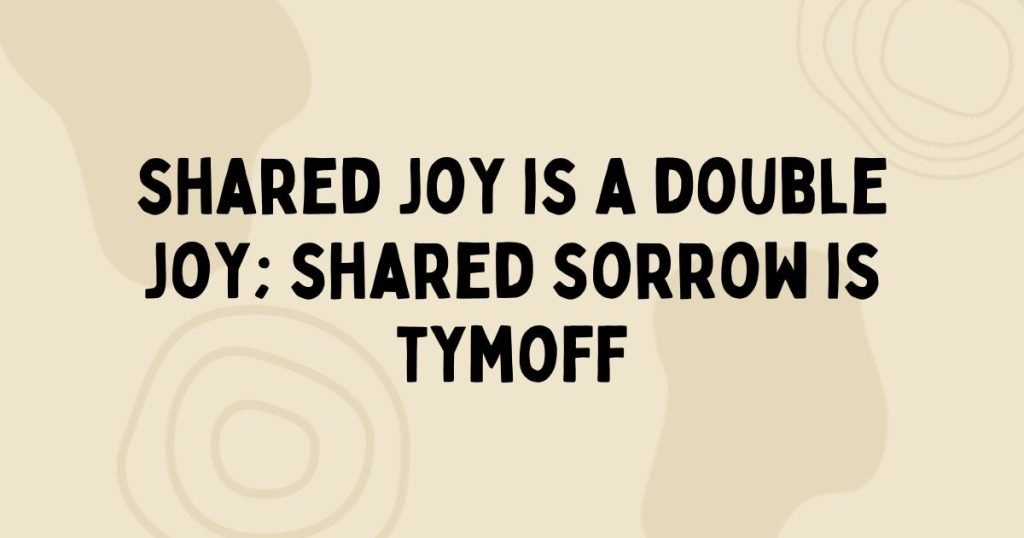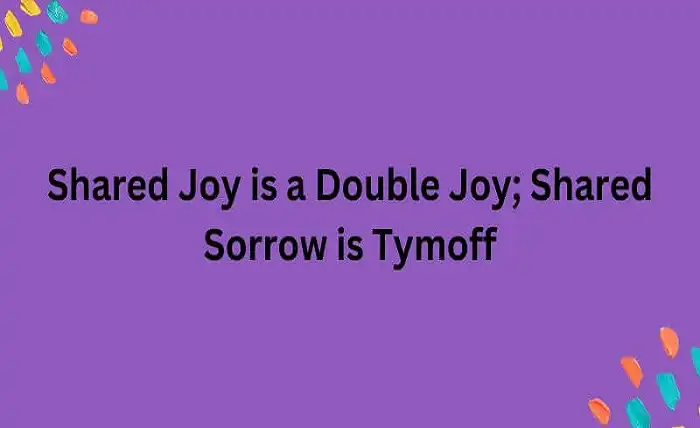In human emotions, the experience of joy and sorrow holds profound significance. How we navigate these emotions and the role of sharing in amplifying or alleviating them has been a subject of philosophical, psychological, and sociological inquiry for centuries. The adage “shared joy is a double joy; shared sorrow is tymoff” encapsulates the essence of communal emotional experiences. This article delves into the depths of this saying, exploring the benefits and mechanisms of sharing joy and sorrow and how these practices shape our well-being and social bonds.
The Nature of Joy and Sorrow
Understanding Joy
Joy is often described as a state of great pleasure and happiness. It can arise from various sources,, such as achievements, relationships, or simple pleasures. Joy characterizes a sense of euphoria, contentment, and a feeling of connection to others and the world around us. It’s a positive emotion that uplifts our spirits and significantly benefits our mental and physical health.
Studies in positive psychology have shown that joy can lead to a healthier immune system, reduced stress, and improved overall well-being. When individuals experience joy, their brain releases chemicals like dopamine and serotonin, enhancing mood and promoting well-being.
The Burden of Sorrow
On the other hand, sorrow is an emotion marked by feelings of loss, disappointment, and grief. Unlike joy, sorrow can have detrimental effects on both mental and physical health. Prolonged sorrow or chronic sadness can lead to conditions like depression, anxiety, and a weakened immune system. Sorrow often stems from experiences such as the death of a loved one, failure, or unfulfilled desires and can leave a person feeling isolated and lonely.
Shared Joy: Multiplying Happiness

The Psychological Basis of Shared Joy
The concept that “shared joy is a double joy” finds its roots in the psychology of emotions. When we share our joyous moments with others, the emotional impact of these moments amplifies. This amplification occurs due to social sharing, where expressing and reliving positive experiences with others strengthens the memory and the emotional response associated with them.
Researchers have found that social sharing of positive experiences increases the perceived value of those experiences. When we celebrate our successes and happy moments with others, their reactions and shared happiness enhance our own, creating a cycle of positivity. This communal celebration creates a ripple effect, spreading joy beyond the initial event and fostering a sense of connection and belonging.
The Role of Social Bonds
Humans are inherently social creatures, and our relationships are crucial to our emotional well-being. Sharing joy with friends, family, or colleagues reinforces social bonds and creates a supportive network. Celebratory events, whether small or grand, unite people, strengthening community fabric and creating a shared sense of happiness.
When people come together to celebrate, the collective energy and enthusiasm create an environment where joy is magnified. This shared experience enhances individual happiness and builds a sense of unity and camaraderie among those involved. The shared joy becomes a collective memory, cherished and remembered by all, further strengthening relationships.
Practical Ways to Share Joy
There are numerous ways to share joy, from simple gestures to elaborate celebrations. Some practical ways to share joy include:
- Celebrating Achievements: Recognize and celebrate milestones and accomplishments, both big and small. Whether it’s a promotion at work, a personal goal achieved, or a special occasion, sharing these moments with loved ones can amplify the joy.
- Expressing Gratitude: Show appreciation and gratitude to those who contribute to your happiness. Expressing thanks can create a positive feedback loop, where the receiver feels valued and reciprocates the positive emotions.
- Creating Shared Experiences: Engage in activities that unite people, such as parties, outings, or even simple gatherings. Shared experiences create lasting memories and strengthen bonds.
Shared Sorrow: The Power of Tymoff
The Concept of Tymoff
The latter part of the adage, “shared sorrow is tymoff,” introduces the term “tymoff,” which can be interpreted as a period or respite needed to process and alleviate sorrow. Sharing sorrow does not eliminate the pain but can make it more bearable and provide a sense of support and understanding.
The Healing Process of Shared Sorrow
When individuals share their sorrow, they often find solace in the empathy and compassion of others. This process of sharing allows individuals to feel heard and understood, reducing feelings of isolation and loneliness. Verbalizing sorrow can also be therapeutic, as it helps individuals process their emotions and gain clarity.
Research in psychology supports the idea that sharing sorrow can facilitate emotional healing. Talking about one’s grief or sadness with empathetic listeners can lead to a reduction in stress and an improvement in emotional well-being. The support of others provides a safety net, allowing individuals to navigate their sorrow knowing they are not alone.

The Role of Empathy
Empathy plays a crucial role in sharing sorrow. When others empathize with our pain, they validate our emotions and provide comfort. This empathetic response can take various forms, such as offering a listening ear, providing comforting words, or simply being present.
The presence of empathetic individuals can create a supportive environment where those experiencing sorrow feel safe to express their emotions. This sense of security and understanding can significantly aid the healing process, making it easier to cope with and eventually move past the sorrow.
Practical Ways to Share Sorrow
Sharing sorrow effectively requires sensitivity and empathy. Some practical ways to share sorrow include:
- Active Listening: Offer a listening ear without judgment or interruption. Allow the person to express their emotions fully and validate their feelings.
- Offering Support: Provide practical support, such as helping with daily tasks, offering a shoulder to cry on, or simply being there for them.
- Creating Safe Spaces: Foster environments where individuals feel comfortable sharing their sorrow. It could be through support groups, therapy sessions, or informal gatherings with trusted friends.
The Balance Between Joy and Sorrow
Emotional Resilience
Navigating the spectrum of emotions, from joy to sorrow, requires emotional resilience. Emotional resilience is the ability to adapt to and recover from emotional challenges. Sharing joy and sadness can enhance emotional resilience by providing support networks and fostering community.
By sharing joy, individuals build positive relationships that buffer against future adversities. These relationships provide strength and support during sorrow, making coping with difficult emotions easier. Conversely, sharing sorrow builds empathy and understanding, strengthening social bonds and creating a foundation of mutual support.
Cultural Perspectives on Sharing Emotions
Different cultures have unique approaches to sharing emotions, influenced by social norms, traditions, and values. In some cultures, communal living and collective celebrations are central to social life, emphasizing the importance of sharing joy. In others, there might be a stronger focus on individual achievements and personal milestones.
Similarly, cultural attitudes towards sorrow can vary. Some cultures encourage open expression of grief and communal mourning, while others may promote a more stoic approach. Understanding these cultural differences can provide valuable insights into how individuals and communities navigate joy and sorrow.
The Impact of Modern Technology
In the digital age, technology has transformed the way we share emotions. Social media platforms, messaging apps, and online communities have created new avenues for sharing joy and sorrow. While these platforms offer convenience and reach, they also come with challenges, such as the potential for superficial interactions and the risk of cyberbullying.
However, when used mindfully, technology can enhance the sharing of emotions. Virtual celebrations, online support groups, and digital storytelling are examples of how technology can facilitate meaningful emotional connections.
Conclusion
The saying “shared joy is a double joy; shared sorrow is tymoff” encapsulates the profound impact of communal emotional experiences. Sharing joy amplifies our happiness and strengthens our social bonds, creating a positive feedback loop that enhances our well-being. Conversely, by sharing sorrow, we find solace in the empathy and support of others, making it easier to navigate difficult emotions.
Understanding the mechanisms and benefits of sharing emotions can help us cultivate healthier, more supportive relationships. Whether through celebratory gatherings, expressions of gratitude, or empathetic listening, sharing emotions plays a crucial role in our emotional and social well-being. In a world where joy and sorrow are inevitable parts of the human experience, sharing offers a path to greater resilience, connection, and fulfillment.








































Leave a Reply